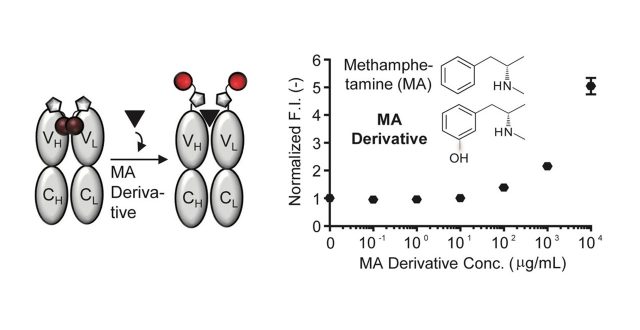The problem of illicit drug use and addiction is an escalating issue worldwide. As such, fast and precise detection methods are needed to help combat the problem. Herein, the synthesis method for an anti-methamphetamine Quenchbody (Q-body), a promising sensor for use in simple
and convenient assays, has been described. The fluorescence intensity of the Q-body generated by two-site labeling of Escherichia coli produced anti-methamphetamine antigen-binding fragment (Fab) with TAMRA-C2-maleimide dyes increased 5.1-fold over background in the presence of a hydroxyl methamphetamine derivative, 3-[(2S)-2-(methylamino)propyl]phenol. This derivative has the closest structure to methamphetamine of the chemicals available for use in a laboratory. Our results indicate the potential use of this Q-body as a novel sensor for the on-site detection of methamphetamine, in such occasions as drug screening at workplace, suspicious substance identification, and monitoring patients during drug rehabilitation.
and convenient assays, has been described. The fluorescence intensity of the Q-body generated by two-site labeling of Escherichia coli produced anti-methamphetamine antigen-binding fragment (Fab) with TAMRA-C2-maleimide dyes increased 5.1-fold over background in the presence of a hydroxyl methamphetamine derivative, 3-[(2S)-2-(methylamino)propyl]phenol. This derivative has the closest structure to methamphetamine of the chemicals available for use in a laboratory. Our results indicate the potential use of this Q-body as a novel sensor for the on-site detection of methamphetamine, in such occasions as drug screening at workplace, suspicious substance identification, and monitoring patients during drug rehabilitation.

